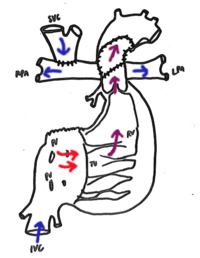
Photo from wikipedia
Objective We evaluated additional pulmonary blood flow at the time of bidirectional cavopulmonary shunt and its effects on the Fontan procedure and long-term outcome of Fontan circulation and liver function.… Click to show full abstract
Objective We evaluated additional pulmonary blood flow at the time of bidirectional cavopulmonary shunt and its effects on the Fontan procedure and long-term outcome of Fontan circulation and liver function. Methods We included 22 patients (16 boys, 6 girls) having undergone bidirectional cavopulmonary shunt with additional pulmonary blood flow between April 2002 and January 2016. Mean age and body weight were 20 ± 13 months and 7.5 ± 6.5 kg, respectively. We retrospectively evaluated the patients’ clinical data, including cardiac catheterization data, liver function, and liver fibrosis markers. Results All patients were alive with a New York Heart Association status of I at the long-term follow-up. Changes between pre-bidirectional cavopulmonary shunt and 101 months after the Fontan procedure included the following: the cardiothoracic ratio of chest X-ray decreased from 52.2 ± 3.9% to 41.8 ± 5.9% ( p < 0.001); systemic ventricle end-diastolic pressure decreased from 11.4 ± 3.2 mmHg to 6.9 ± 3.6 mmHg ( p < 0.001); and the pulmonary artery index decreased from 485.1 ± 272.3 to 269.5 ± 100.5 ( p = 0.02). Type IV collagen, hyaluronic acid, and procollagen levels increased over the normal range 116 months after the Fontan procedure. Conclusions The additional pulmonary blood flow at the time of bidirectional cavopulmonary shunt may contribute to pulmonary arterial growth at the Fontan procedure with low pulmonary arterial resistance and without ventricle volume overload. The Fontan circulation was well-maintained at the long-term follow-up, while liver fibrosis markers were above their normal values.
Journal Title: Journal of Cardiothoracic Surgery
Year Published: 2020
Link to full text (if available)
Share on Social Media: Sign Up to like & get
recommendations!